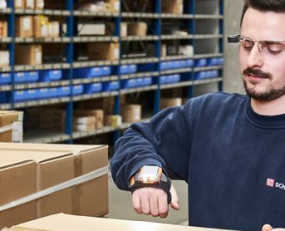
DB Schenker has introduced Picavi’s smart glasses in order-picking operations, with the goal of implementing the smart picking solution as standard procedure across multiple locations. During a trial period, the smart picking application was explored in Bremen and Rodgau, Germany, with the team in Rodgau combining the solution with intelligent scanning glove ProGlove.
Picavi uses Google Glasses to project required information into the user’s field of vision. This means warehouse workers have both hands available for their primary work of picking goods instead of holding a hand scanner and paper documents. The innovative, handsfree solution maximises productivity while minimising error rates.
ProGlove is an intelligent scanning glove which is activated by pressing a button on the glove, allowing employees to use both hands for picking and further increasing productivity. ProGlove is already in use at DB Schenker’s warehouse in Eching, near Munich.
DB Schenker’s location in Bremen supplies contract logistics solutions for the automotive industry. The usage of Picavi glasses led to a measurable and direct increase in efficiency compared to the previously hand-held scanners. Employees praised their ergonomic advantages and ease-of-use. The second implementation took place in Rodgau, near Frankfurt, where Picavi glasses are used in combination with ProGlove to further increase efficiency.
The smart-picking solution consists of two components: the glasses and either a finger ring or scanning glove. After the ordered item is picked, which is recorded by the ring or glove scanner, the next order is displayed on the lens of the glasses. The user only needs to look up slightly, meaning their normal field of vision is not compromised. The system is controlled using buttons on the battery pack, which weighs just 200 grams and is attached to the employee’s belt.
The cooperation with Picavi is the latest project in digitalisation and innovation, as DB Schenker works to create the warehouse of the future. Other recent examples include virtual reality training for forklift drivers and the implementation of exoskeletons to relieve warehouse employees of heavy loads.
Source: DB Schenker